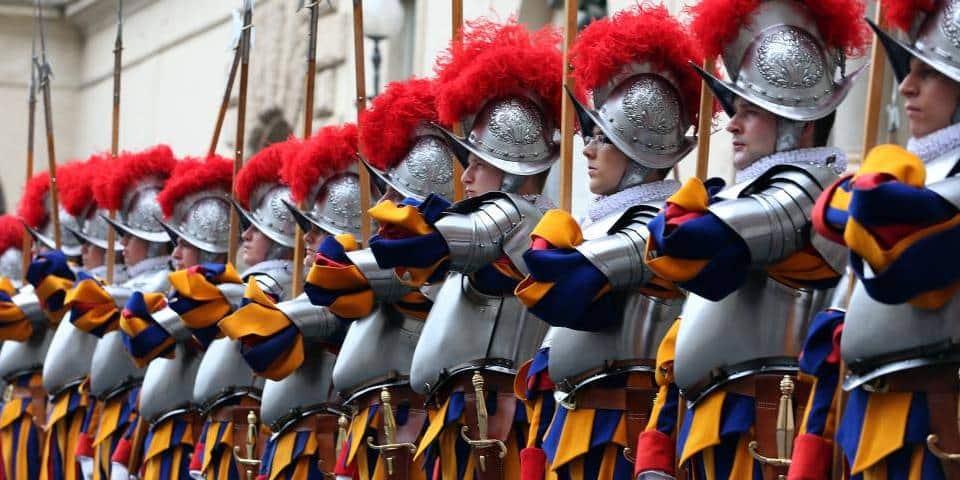

24907 views
Written by: Kate Zusmann

The Pontifical Swiss Guard, also called Papal Swiss Guard (Latin: Cohors Helvetica or Cohors Pedestris Helvetiorum a Saca Custodia Pontificis), is an army maintained by the Holy See, responsible for the security service of the Pope, including the protection of the Apostolic Palace. In addition, the Pope’s bodyguards serve as military of the Vatican City. The Swiss Guard was established in 1506 under Pope Julius II.
In total, there are 110 Swiss Guards. The army consists of a leader (Commandant), four officers, six sergeants, a priest, one staff sergeant, ten corporals, and ten vice corporals. Other seventy-seven guards are halberdiers.
Contents
ToggleAccording to history, the Pontifical Swiss Guard was created by Pope Julius II, known as “the warrior pope,” on January 22, 1506. 150 pope’s swiss guards, led by Captain Kaspar von Silenen, who came to Rome through the Porta del Popolo. They reached St Peter’s, where the Pope blessed them for the Benediction Loggia.
The Pope’s security service started to exist more than 500 years ago and today, the powerful armory army is responsible for current Pope Francis’s safety.
The Guards had a stern test of their experience several years later, “The Sack of Rome.” On May 6, 1527, Emperor Charles V’s troops plundered Rome, mainly Spanish soldiers, and German mercenaries. That day, 147 dead bodies of soldiers were seen at the Vatican, who ensured Pope Clement VII’s safe escape to the Castle of Angels (Castel Sant’Angelo). For this reason, recruits take their oath of Loyalty on May 6, which is the date of the anniversary of the sack of Rome of 1527.
Moreover, the ceremony takes place in the historic St. Damaso courtyard, the Vatican. First, the oath is read in the four official languages of Switzerland: Latin, German, French, and Italian. Then, each recruit confirms the commitment in the language he speaks, holding the Guard’s standard in his left hand and raising a good hand with three fingers open, representing the Holy Trinity.
The Swiss Guard is the smallest army in the world
The Pope’s choice to hire Swiss mercenaries was connected to their reputation of being invincible and loyal. However, in 1870, when the peninsula of Italy suppressed the Papal States, the Swiss Guard took on a different meaning. It stopped being an army in the traditional sense of the word, although we still refer to it as the army. Moreover, in 1874, by changing the Swiss constitution, the hiring of soldiers of foreign powers became outlawed. In addition, by 1927, Bern prohibited Swiss nationals from enlisting in other nations’ military forces. However, the Vatican guard was exempt from new restrictions.
Today, the Swiss Guard functions much as a ceremonial unit, but they are professionally trained to use weapons to protect the Pope
The costumes of the special forces are blue, red, orange, and yellow with a Renaissance-inspired appearance. Considering details, the red and blue colors of the uniform were of the della Rovere family, to which Pope Julius belonged. In contrast, red embodied the color of the Medici family, of which Pope Clement VII was a member.
There was a rumor that the designer of the uniform was either Michelangelo of Raphael
However, Michelangelo had no connection to creating the uniform, while Raphael only inspired its puffed sleeves. The “Gala uniform,” which we know today, was introduced in the early 20th century by Commander Jules Repond.
The uniform is usually worn with a blue basque cap.
At Easter, Christmas, and the swearing-in ceremonies, a 17th-century armor is added to the uniform, including a silver helmet with ostrich feather. Another kind of uniform, “Exerzieruniform” (excursive uniform), is used for training throughout night duties and at the entrance to St. Anne’s.
The soldiers are equipped with traditional weapons, such as halberd and modern firearms. However, one of the most notable aspects of the Swiss Guard is their vintage armory. Vintage armor and edged weapons – primarily the sword and the halberd are still used today.
The modern invasion among army weapons is the “Swiss Army Knife,” a self-protection staple of every Swiss citizen and is widely used outside the army. These knives are multi-functional tools and exist in different sizes and functional combinations. They can be found in the pocket of every Vatican Swiss Guard.
Moreover, the corps works alongside the Gendarmerie Corps of Vatican City State, the gendarmerie, or police of the Vatican.
The primary responsibilities of the Swiss Guard are:
The Pontifical Swiss Guard Banner is divided by a white cross into four corners. One can see red, yellow, and blue colors on the upper right and lower left corners, which are colors of the Guard. Moreover, the design of the banner has been changed several times. The lower-left corner contains the representation of the arms of Pope Julius II, while the ruling components of the Pope are embodied in the upper left corner. Also, there is the depiction of the Guard’s commander’s arms in the center of the flag.
Not any person can join Pope’s personal security forces. There are unique criteria for guards to get a job: the candidate must be an unmarried Swiss Catholic male between 19 and 30 years old trained with the Swiss Armed Forces. Guards can marry after getting 25 years old after serving for three years or more. Here, they commit themselves to serve another three years and are at least at the rank of Corporal. Also, each candidate must have done in the Swiss army and contain either a professional diploma or a high school degree. Undoubtedly, the reputation of the applicant must be impeccable.
The Pope pays attention to the criteria that applicants must be at least 174 cm tall, while Swiss nationality is a prerequisite for joining the Corps.
The yearly salary for an entry-level worker in the Pope’s security army is 15.600 euro per year (around 20.000 $). Moreover, guards are provided with food and accommodation. Depending on the status, employed guards get paid more. Another essential feature of any member of the Swiss Guard is access to the territory of the Vatican City-State, where only holders of the government’s passport or permit to stay can cross its borders.
Being one of the Swiss Guard’s members is a huge responsibility. You can see the representatives of the most miniature army in the world during your visit to the Vatican. Tell us in the comments about your experience and opinion related to the security service of the Pope!
Author: Kate Zusmann
This website uses cookies. For more info read the cookies policy
Rome.us © 2026. Created with love by Roman experts and guides.